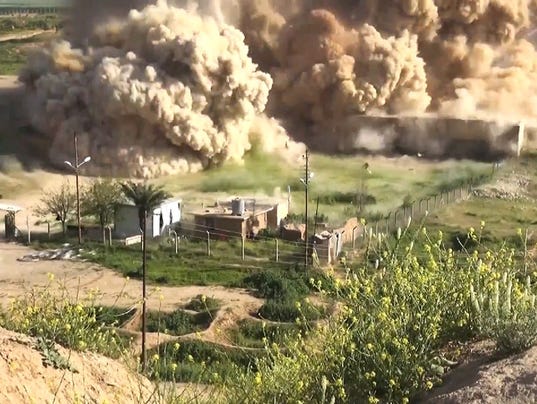By Kathryn Maureen Ryan
Impunity Watch, Managing Editor
BAGHDAD, Iraq – A video released by the Islamic State of Iraq and the Levant (ISIS) shows militants using power tools and bulldozers to deface and destroy monuments in the ancient Assyrian city of Nimrud in northern Iraq, before the site was completely destroyed with explosives. The video comes only a week after another video showed the destruction of the UNESCO cite at the Ancient city of Hatra. Damage to Nimrud was first reported in March but the new video shows the full scale of the destruction of the historic cultural site which has stood for more than 3,000 years surviving countless conflicts and regimes.

Nimrud, which was once the capital of the ancient Assyrian Empire and a major Assyrian city from about 1250BC to 610BC, is located 20 miles south of the modern city of Mosul and is just 3 miles outside the small village of Selamiyah, is a UNESCO World Heritage Site and is considered one of most important archaeological sites in Iraq. Nimrud was first excavated by modern archeologists in the 19th century when many of its artifacts were removed from their homeland and transported to Europe’s largest museums including the British Museum and the Louver, Sadly these artifacts that were once stolen from Nimrud and the Iraqi are now among the only surviving artifacts from the city following its horrific destruction.
Flashpoint Intelligence, a global security firm, could not confirm that the site shown in the video is in fact the ancient city of Nimrud. However, the organization said “online chatter does seem to corroborate the claims, and the rest of the video does follow the group’s pattern of destroying ‘idols,’ as they call it.” If confirmed, this destruction of cultural sites that belong not only to the people of Iraq but all of humanity, is a crime under international law. The loss of the city of Nimrud is a tragedy not only for the people of Iraq but for humanity, the city represents the cultural achievements of Ancient Mesopotamia, considered by many to be the birthplace of both agriculture and western civilization
ISIS has targeted several other Assyrian sites in Iraq and destroyed countless manuscripts, books and other artefacts that they have declared to be un-Islamic and blasphemous. The group recently destroyed a library in Mosul that contained more than 8,000 ancient manuscripts Irinia Bokova, the director general of the United Nations Educational, Scientific and Cultural Organization, (UNESCO) has previous condemned the destruction of key historical sites by ISIS saying that the “deliberate destruction of cultural heritage constitutes a war crime.”
Earlier this year’s ISIS supports claimed they were ordered by the Profit to commit these acts of Iconoclasm, the deliberate destruction of cultural and religious idols of other cultures, saying, “the Prophet ordered us to get rid of statues and relics, and his companions did the same when they conquered countries after him.” While the militants claim their actions are motivated by a desire to destroy what it sees as idolatry ISIS itself does not destroy all artifacts its encounters, instead the illegal looting and selling of antiquities is a primary source of ISIS funding.
For more information please see:
NBC News – ISIS Video Shows Apparent Destruction of Nimrud Archaeological Site – 12 April 2015
The Jerusalem Post – WATCH: ISIS Razes Ancient City in Latest Bid to Erase ‘Un-Islamic’ History – 12 April 2015
USA Today – Video Purports To Show ISIL Destroying Ancient City of Nimrud – 12 April 2015
The Guardian – Isis Video Confirms Destruction at UNESCO World Heritage Site in Hatra – 5 April 2015
